Cystic fibrosis is an illness best known for causing frequent lung infections and chronic breathing problems. However, it affects organs and tissues throughout the body, including the urogenital system.
A majority of men (between 97 and 98 percent) with cystic fibrosis have congenital bilateral absence of the vas deferens (CBAVD)--the ducts that carry sperm from the testes to the urethra--resulting in a lack of sperm in the semen.
The condition is called obstructive azoospermia and is a cause of infertility. Until recently, most men with cystic fibrosis could not father children. Assisted reproduction now makes fatherhood possible for these men.
Underlying Genetics of Infertility
The absence of vas deferens is caused by the same genetic mutation that causes cystic fibrosis. A mutation of the cystic fibrosis transmembrane conductance regulator disrupts the transport of salts in and out of cells. This affects the fluid balance in cells, resulting in production of a thick, sticky mucus instead of normal mucus. The mucus clogs the airways in the lungs, causing breathing problems and trapping bacteria, which leads to frequent infections.
The CFTR gene also influences the formation of the ejaculatory duct, seminal vesicle, vas deferens, and epididymis. The exact mechanism by which CFTR causes these abnormalities is not known. It could be a direct result of the defective gene, or a secondary effect of degenerative changes caused by abnormal secretions.

Cystic Fibrosis (mucoviscidosis) inheritance. Image Credit: Zuzanae / Shutterstock
One clue pointing to a primary genetic effect is the fact that CBAVD can be caused by a mutation of the CFTR gene without any other clinical manifestations of cystic fibrosis.
Starting a family if you have cystic fibrosis | Support
Fertility Interventions
There is no way to correct an absence of the vas deferens. However, about 90 percent of men affected by this condition still produce sperm and can father children using assisted reproductive technologies.
One method is sperm retrieval using microsurgical epididymal sperm aspiration (MESA), percutaneous epididymal sperm aspiration (PESA), or testicular sperm aspiration (TESA). These are all methods of surgically extracting sperm from the testes. They differ in the approach and methods used.
Fertilization rates using the harvested sperm range from 37 to 48 percent, and pregnancy rates are around 30 percent per attempt--very similar to the success of a single natural conception cycle.
Harvesting of sperm is typically combined with ovarian hyperstimulation in the female partner and in vitro fertilization to optimize the chances for success.
Genetic Counseling
Cystic fibrosis is a hereditary disease. For any couple in which one partner has cystic fibrosis, genetic testing and counseling are important. The partner of a person with cystic fibrosis should undergo cystic fibrosis carrier testing to assess the risk of cystic fibrosis in any children born as a result of infertility treatment.
Contraception
Although most men with cystic fibrosis are infertile, not all are. Men who have not been tested for infertility and do not wish to have children should use contraception to prevent unplanned pregnancy.
Female Reproductive Issues
Cystic fibrosis does not cause infertility in women to the extent that it does in men. However, some side effects and complications of cystic fibrosis can affect the female reproductive system, and may make conception more difficult.
Antibiotics and corticosteroids taken on a regular basis to control cystic fibrosis complications can lead to vaginal fungal infections. This may cause itching, irritation, discomfort, and pain during sex or urination. Men with cystic fibrosis can also be affected by fungal infections, known as male candidiasis. The infection can be treated with creams or oral medications.
Cystic fibrosis can also lead to absent or irregular periods in women. This is due to poor nutrition, low body weight, and poor lung function disrupting ovulation in women with the disease. Puberty may also be delayed in girls.
Although cystic fibrosis does not cause the absence of reproductive structures in females as it does in males, the disease can reduce fertility in women. Studies in mice with cystic fibrosis have shown some changes leading to reduced fertility including smaller ovaries, smaller uteri, irregular estrous cycles, and decreased ovulation.
Infertility in women with cystic fibrosis can generally be addressed through the same treatments used in infertile women without cystic fibrosis.
References
- Curr Opin Pulm Med, Infertility in men with cystic fibrosis, https://www.ncbi.nlm.nih.gov/pubmed/11706320
- Cystic Fibrosis Foundation, Fertility in Men with CF, https://www.ncbi.nlm.nih.gov/pubmed/11706320
- Cystic Fibrosis Foundation, Common Issues on Women with CF, https://www.cff.org/Life-With-CF/Transitions/Reproductive-Health-and-Fertility/CF-and-the-Female-Reproductive-System/Common-Issues-in-Women-With-CF/
- Cystic Fibrosis Medicine.
- Endocrinology, Infertility in Females with Cystic Fibrosis is Multifactorial: Evidence from Mouse Models, https://www.ncbi.nlm.nih.gov/pmc/articles/PMC2408809/
Further Reading
Last Updated: Dec 29, 2022